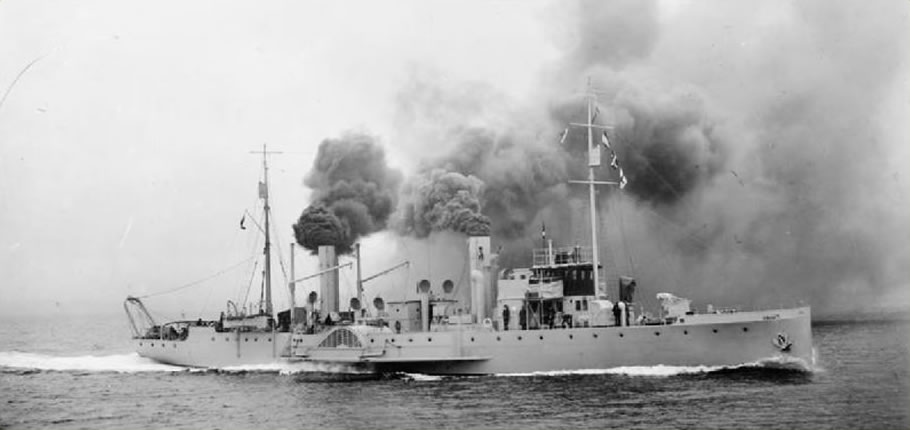
Minesweepers & Trawlers – World War 1
The Mine-sweeping force based at Harwich played an important First World War role; The task of the mine-sweeping force was to keep shipping lanes clear. The force consisted of about 100 minesweeping trawlers, with a complement of roughly 1500 personnel.

Paddle minesweepers, Harwich, 15th April 1918. © IWM.
The Naval Trawler is a concept for expeditiously converting a nation’s fishing boats and fishermen to military assets. England used trawlers to maintain control of seaward approaches to major harbours. No one knew these waters as well as local fishermen, and the trawler was the ship type these fishermen understood and could operate effectively without further instruction. The Royal Navy maintained a small inventory of trawlers in peacetime, but requisitioned much larger numbers of civilian trawlers in wartime.
The larger and newer trawlers and whalers were converted for antisubmarine use and the older and smaller trawlers were converted to minesweepers
At the beginning of World War 1, British regular minesweeping forces comprised 10 ex-torpedo gunboats fitted with the Actaeon or ‘A’ sweep in 1908/95.
By 8 August 1914, 94 fishing trawlers had been mobilised and converted for minesweeping.
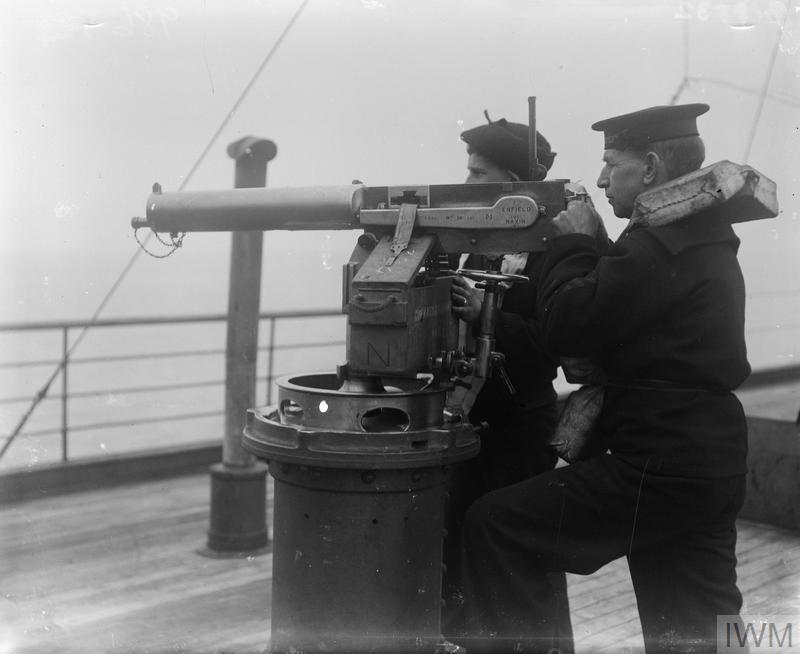
Sailors operating a Maxim gun, Harwich, 15th April 1918. © IWM.
The “Trawler Reserve” was a combination of fishing vessels manned by fisherman together with GER vessels and Paddle steamers. Other GER steamers were used as supply and hospitals ships, as well as taking cargo and passengers back and forth to neutral Holland. Had the important task of clearing enemy mines from the sea routes, and attacking enemy mine-laying submarines, for which they received a prize for every vessel destroyed. The Harwich Company numbered under 100 trawlers, mine drifters and steamers, manned by 1500 men.
This was vitally important but extremely dangerous programme; in 1917 the paddle steamers alone destroyed around 400 enemy mines.
By 22 Aug, a further 100 trawlers had been commandeered and fitted out. By the end of the war, British minesweeping forces comprised 726 vessels including 110 regular naval vessels (mostly Acacia Class, Azalea Class, Arabis Class, Hunt Class and Aberdare Class Fleet Sweeping Sloops), 412 trawlers, 142 drifters, 52 hired paddle steamers and 10 Dance Class ‘Tunnel Tug’ shallow draught minesweepers.
214 British minesweepers had been lost in action while sweeping over 30,000 mines.
Agamemnon II
- Type. Steam Trawler
- Built. 1906
- Pennant. GY187
- Builder. Cochrane & Sons
- Speed. 10.5 knots
- Launched. 1906
- Requisitioned. 1914
- Fate. Sank 15/07/1915
HMT Agamennon was a admiralty trawler hired in 1914 as minesweeper, No.19, Harwich-based, Skipper Frederick Sibley RNR. With other Harwich sweepers clearing minefield discovered that morning, and in fact laid that morning by UC.1 Sank off the Shipwash Sands, off Orford Ness 9 ratings lost.
Ameer
- Type. Steam Minesweeper Trawler
- Pennant. CY397
- Builder. T&W Smith
- Launched. 1908
- Tonnage. 216 grt.
- Fate. 18/03/1916
-
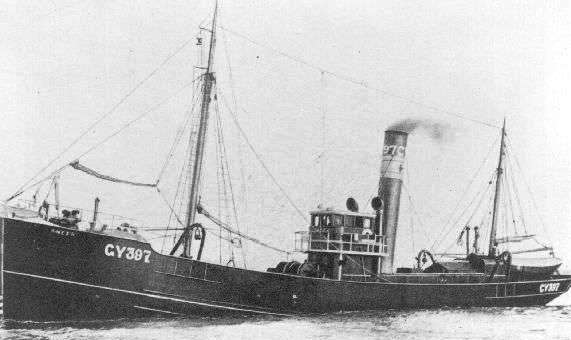
HMT Ameer
HMT Ameer was sunk on 18th March 1916 by a mine from the German submarine UC-7, off Felixstowe. 8 of the crew were killed.
Angus, Alexander (28), Engineman (no. 56ES).†18/03/1916, Memorial: Chatham Naval Memorial.
Bailey, William Alfred, Signalman (no. T6/171).†18/03/1916, Memorial: Shotley(St. Mary’s) Churchyard.
Benson, George Walter, Second Hand (no. 73/DA).†18/03/1916, Memorial: Hull Western Cemetery.
Christie, William (33), Deck Hand (no. 3682/DA).†18/03/1916. Memorial: Shotley (St. Mary’s) Churchyard
Coultas, Charles (39), Engineman (no. 236ES).†18/03/1916, Memorial: Chatham Naval Memorial.
Kemp, Frederick Robert (46), Skipper. 18/03/1916, Memorial: Hull Western Cemetery.
Shell, Adam (34), Deck Hand (no. 6708DA). †18/03/1916, Memorial: Chatham Naval Memorial.
Smith, Alfred Ernest , Deck Hand (no. 1762DA).†18/03/1916, Memorial: Chatham Naval Memorial.
Atherstone
- Type. Racecourse Minesweeper
- Built. 1916
- Builder. Ailsa Shipbuilding
- Ordered. 1915
- Launched. 04/04/1916
- Commissioned. 1916
- Speed. 15 knots
- Displacement. 810 tons
- Fate. Scrapped 14/03/1952
-
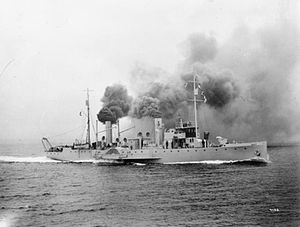
HMS Atherstone
HMS Atherstone was a Racecourse-class minesweeper of the Royal Navy. Built by Ailsa Shipbuilding at Troon in Scotland, she was launched on 14 April 1916. For the rest of the war she served with the Auxiliary Patrol. Post war she was transferred to the Mine Clearance Service. She was sold to The New Medway Steam Packet Company on 12 August 1927 and converted for excursion work on the Medway and Thames. She was renamed Queen of Kent. For the next twelve years she could be found working from Sheerness and Southend. Regular excursions took her to Gravesend, Margate, Clacton and Dover.
In September 1939 she was requisitioned by the Admiralty for minesweeping duties once more and commissioned as HMS Queen of Kent, pennant number J74. For Operation Overlord in June 1944 she was stationed at Peel Bank off the Isle of Wight as the Mulberry Accommodation & Dispatch Control Ship. Subsequently she was stationed at Dungeness. After the war she was returned in 1946 to her owners to recommence excursion work around the Thames Estuary.
In January 1949 she was sold to Red Funnel and transferred to Southampton. After refitting at Thorneycroft’s yard at Northam she was commissioned in the spring as the company’s second Lorna Doone. For the next three years she operated excursions from Bournemouth in the summer. She was finally withdrawn and scrapped by Dover Industries Ltd at Dover Eastern Docks in 1952.
Burnley
- Type. Steam Trawler
- Built. 1916
- Pennant. 3277
- Builder. Smith’s Dock
- Speed. 10 knots
- Displacement. 275 tons
- Fate. Sunk 25/11/1916
HMT Burnley was a steam fishing Trawler Built by Smith’s Dock Co, Middlesbrough in 1916. On November 25th, 1916, the British navy hired trawler Burnley was sunk by a mine from the German submarine UC-4 off Orfordness. 19 persons were killed.
The Harwich Royal Naval Reserve and Royal Naval Volunteer Reserve Auxiliary and Minesweeping Patrol Memorial (situated at the junction of Lower Marine Parade and Fronks Road on Harwich seafront) commemorates those officers.
Cheltenham
- Type. Racecourse Minesweeper
- Built. 1916
- Pennant. T54
- Builder. Ardrossan Dry Dock
- Ordered. 1915
- Laid Down. 1915
- Commissioned. 1916
- Speed. 15 knots
- Displacement. 810 tons
- Fate. Scrapped 07/10/1927
-

HMS Cheltenham
HMS Cheltenham was a Racecourse class minesweeper of the Royal Navy built on the 12th April 1916 by Ardrossan Dry-dock & Shipyard. She was sold for breaking on the 7th October 1927 at Newport.
Dane
- Type. Steam Trawler
- Built. 1913
- Pennant. GY947
- Builder. Cochrane & Sons
- Speed. 10 knots
- Displacement.265 tons
- Commissioned. 1915
- Fate. Mined 28/08/1915
HMT Dane was a admiralty trawler launched in 1913 for ‘D’ Line Steam Fishing, Grimsby and hired in 1915 as auxiliary patrol vessel, No.1446, believed Harwich-based, Lt Parker RNR. Mined at 0750, laid by UC.6, sank 1 mile of North Aldeburgh Napes buoy, Suffolk, 5 killed.
De La Pole
- Type. MS Steam Trawler
- Built. 1911
- Pennant. FY558
- Builder. Cook, Welton & Gemmell
- Laid Down. 1911
- Speed. 10.5 knots
- Displacement. 255 tons
- Fate. Wrecked 04/02/1916
-
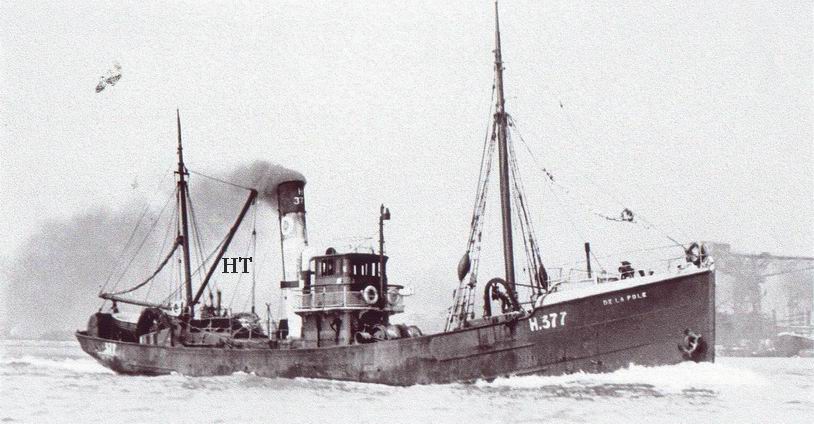
HMT De La Pole
HMT De La Pole was built by Cook Welton & Gemmell and launched on the 10th October 1911. The vessel was wrecked on the Goodwin Sands on the 4th of February 1916, The deal lifeboat went to the vessel in response to distress signals, the De La Pole was full of water and of her 12 man crew 8 were lashed to the rigging, the vessel was breaking up rapidly but by means of lifeline the crew were taken aboard the lifeboat although one man was fatally injured.
Duchess of Fife
- Type. Paddle Steamer
- Built. 1903
- Pennant. PP533
- Builder. Fairfield
- Ordered. 1903
- Laid Down. 1903
- Commissioned. 1916
- Speed. 17 knots
- Fate. Scrapped 05/09/1953
-
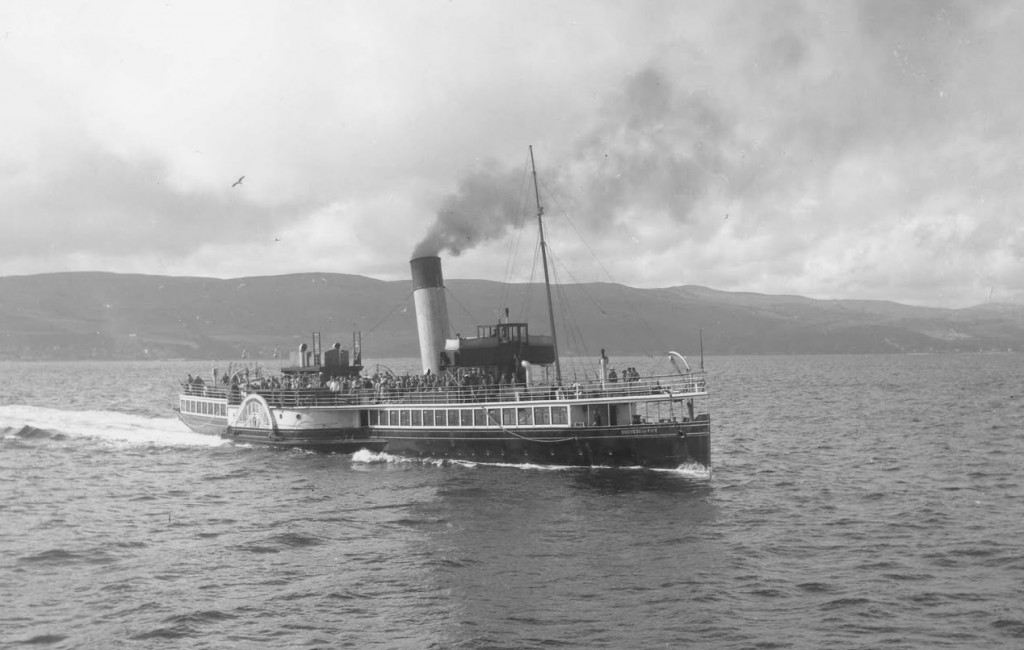
Ps Duchess of Fife
PS Duchess of Fife was a Paddle Steamer launched on the 9th May 1903 by Fairfield Shipbuilding, and taken into Royal Navy service from 1916 to 1919. The vessel was sold in 1923 and scrapped in 1953.
Duchess of Hamilton
- Type. Paddle Steamer
- Built. 1890
- Pennant. 933
- Builder. William Denny
- Ordered. 1889
- Laid Down. 1889
- Commissioned. 1915
- Speed. 17 knots
- Fate. Sank 29/11/1915
-
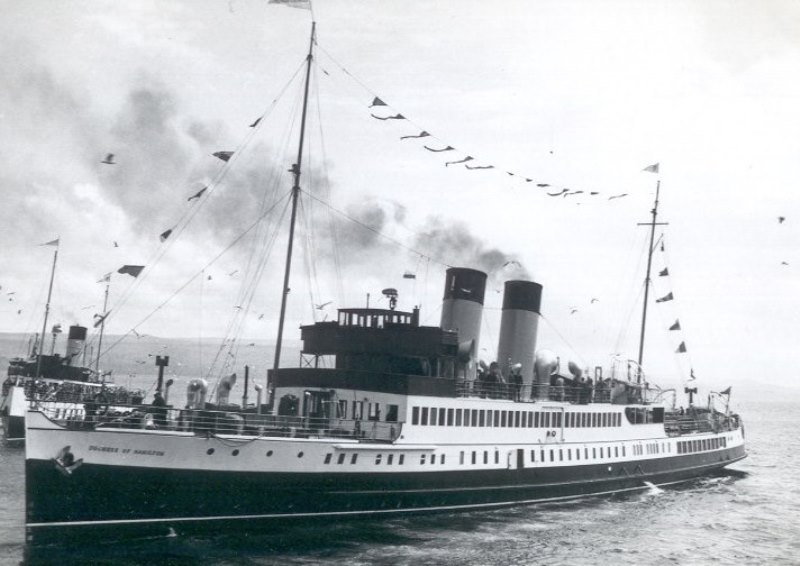
Duchess of Hamilton
HMS Duchess of Hamilton was an Auxiliary paddle minesweeper built in 1890 by W Denny, Dumbarton and owned by the Caledonian Steam Packet Co. On November the 29th 1915 Duchess of Hamilton was sunk by a mine laid possibly by UC.3 near the Galloper Lightship, Thames. 9 Persons were lost.
Fareham
- Type. Hunt Class Minesweeper
- Built. 1918
- Pennant. J89
- Builder. Dunlop Bremner
- Ordered. 1917
- Laid Down. 1918
- Commissioned. 1918
- Speed. 16 knots
- Fate. Scrapped 24/08/1948
-
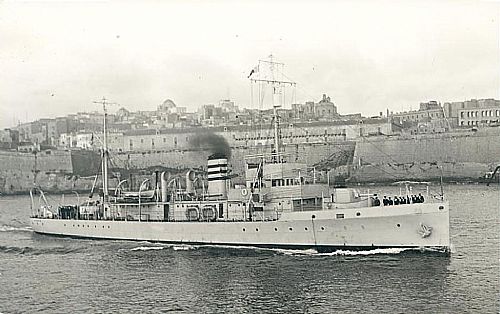
HMS Fareham
HMS Fareham was a Hunt Class minesweeper built by Dunlop Bremner & Co, Glasgow. She was launched on the 7th June 1918. History: November 1918 – 6th Minesweeper Flotillas. Harwich, 4th July 1919 – Sailed Harwich for Gibraltar. In 1944–45 she was named St Angelo II, acting as a minesweeping base ship.
Holdene
- Type. Fishing Trawler
- Built. 1915
- Pennant. FY437
- Builder. Smith’s Dock
- Launched. 1915
- Speed. 10 knots
- Displacement. 274 tons
- Fate. Sank 02/02/1917
HMT Holdene was a British fishing trawler built in 1915 by Smith’s Dock Co, Middlesbrough and operated at the time of her loss by Royal Navy, On February 2nd, 1917, Holdene was sunk by a mine from the German submarine UC-11 east from the Shipwash light vessel. 7 persons were lost.
Japan
- Type. Steam Trawler
- Built. 1904
- Pennant. FY42
- Builder. Cochrane & Sons
- Speed. 10 knots
- Displacement. 205 tons
- Commissioned. 1915
- Fate. Mined 16/08/1915
HMT Japan was at sea with HMT Touchstone on Monday 16th August 1915 and were clearing their sweeps that afternoon off the south end of the Shipwash Shoal when a mine was observed floating 30 yards away, foul of the sweep wire. At the time, the Japan was the winch boat, heaving in the sweep. The man who was attending the winch shouted to stop heaving, but before he was heard the mine was within three yards of the vessel. Steps were taken to ease the sweep out, causing the mine to submerge and drift beneath the trawler, and 10 seconds later the vessel blew up, killing PO T. Wooldridge; 2nd Hand J. Westcott; deck hands T. Richardson, C. Wing and H. Moisey. The bodies of the latter two were picked up by HMT’s Lord Roberts and Touchstone and landed at HMS Ganges, Shotley. The mine was fresh, painted red, had five horns and was 2.5 feet in diameter. The Officer-in-Charge, Lt R. M. Harcourt RNR and Mr A. W. Barber, skipper, were held to blame for not keeping headway on the ship by using her engine. The explosion took place under the port side of the winch at a of depth 2.25 fathoms. The vessel sank in 30 seconds and the survivors were in the water for only 15 minutes, 5 crew were lost.
“The Trawlers of Grimsby”
Javelin
- Type. Steam Trawler
- Built. 1913
- Builder. Hall & Co
- Speed. 10 knots
- Displacement. 205 tons
- Fate. Sank 17/10/1915
HMT Javelin was an Admiralty owned trawler built by Hall & Co, Aberdeen and launched in 1913. The naval trawler struck a mine laid by the German Submarine UC-3 in the North Sea 3 nautical miles south of the Longsand Lightship with the loss of 1 crew member.
Lady Ismay
- Type. Steel Paddle Steamer
- Built. 1911
- Builder. Ailsa Shipbuilding
- Launched. 01/06/1911
- Commissioned. 1914
- Displacement. 451 grt
- Fate. Mined 21/12/1915
-
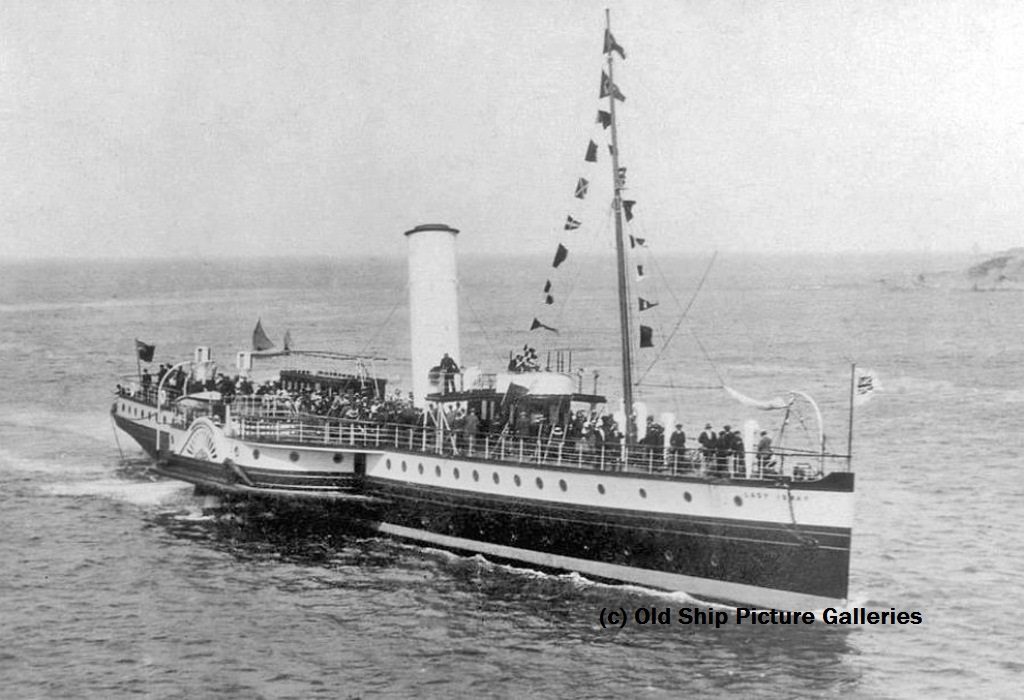
Lady Ismay
Lady Ismay sailed from Harwich in the morning with 6 other paddle minesweepers to sweep area to the SW. Visibility poor around noon, three of the vessels separated and left for Harwich, wireless signal to the other four including Lady Ismay not received, they slipped sweeps at 1500 and in order Westward Ho, Cambridge, Lady Ismay, Glen Avon headed for Longsand LV, off Clacton, Essex. [J/dx – 21/12/17] – First two paddlers passed the LV on the starboard hand but tide forced Lady Ismay to pass on port hand, set course for the LV, at around 1540 mined amidships beneath forward bunker and sank within a minute [J/dx – near the Galloper; He – 1 mile NW of LV; un – LV S40°E 5 cables; wi – between Longsand Head and the Galloper, in 51.45N 01.49E;]. Mine laid some days earlier by UC.3 (Erwin Wassner).
17 ratings, 2 MN lost, only those on deck survived including the mate, she went down so quickly survivors stepped into the lifeboats, Glen Avon just astern stopped and rescued some of the men with her boats, the other two turned back, Cambridge also lowered her boats, picked up survivors and destroyed confidential papers floating on the water. www.naval-history.net.
- Albery, Joseph , Stoker (no. 1423u),†21/12/1915, Memorial: Chatham Naval Memorial.
- Anderson, George William (24), Deck Hand (no. 6029/da),†21/12/1915, Memorial: Chatham Naval Memorial.
- Bell, Richard Callaway (46), Petty Officer 1st Class (no. 128146), †21/12/1915, Memorial: Shotley.
- Bennett, Leonard Joseph (29), Seaman (no. 1331x),†21/12/1915, (Newfoundland) Memorial.
- Blasdale, Tom Harry (40), Deck Hand (no. 8374da),†21/12/1915, Memorial: Chatham Naval Memorial.
- Brocklesby, Percy (26), Engineman (no. 3674es),†21/12/1915, Memorial: Chatham Naval Memorial.
- Frosdick, Dennis (42), Trimmer (no. 4130ts), 21/12/1915, Memorial: Chatham Naval Memorial.
- Harris, Herbert, Deck Hand (no. 8312da),†21/12/1915, Memorial: Chatham Naval Memorial.
- Henderson, Arthur John, Engineman (no. 294ES),†21/12/1915, Memorial: Chatham Naval Memorial.
- Johnson, James, Deck Hand (no. 8272da),21/12/1915, Memorial: Chatham Naval Memorial.
- Sanderson, Benjamin (29), Deck Hand (no. 8310da),†21/12/1915, Memorial: Chatham Naval Memorial.
- Scanlon, Thomas Joseph (21), Trimmer (no. 88st),†21/12/1915, Memorial: Portsmouth Naval Memorial.
- Sharpe, Robert, Trimmer (no. 4254ts), 21/12/1915, Memorial: Chatham Naval Memorial.
- Shortland, John (18), Deck Hand (no. 8458da),†21/12/1915, Memorial: Chatham Naval Memorial.
- Taylor, George, Trimmer (no. 3770ts), 21/12/1915, Memorial: Chatham Naval Memorial.
- Webster, Benjamin (23), Trimmer (no. 4135ts), 21/12/1915, Memorial: Chatham Naval Memorial.
- Whitehead, Patrick, Deck Hand (no. 2181da), 21/12/1915, Memorial: Chatham Naval Memorial.
Ladysmith
- Type. Steam Trawler
- Built. 1906
- Pennant. GY183
- Builder. Cochrane
- Speed. 9 knots
- Displacement. 254 tons
- Fate. Sank 27/12/1915
HMT Ladysmith was a Navy Trawler built in 1906 by Cochrane & Sons, She was damaged by a mine in the North Sea and towed to Harwich for repairs. The naval trawler foundered in the Irish Sea off the coast of Wales on the 27th of December 1915.
Lord Roberts
- Type. Steam Trawler
- Built. 1907
- Builder. Earle’s Shipbuilding
- Ordered. 1906
- Laid Down. 1906
- Speed. 10 knots
- Displacement. 293 tons
- Fate. Sank 26/10/1916
-
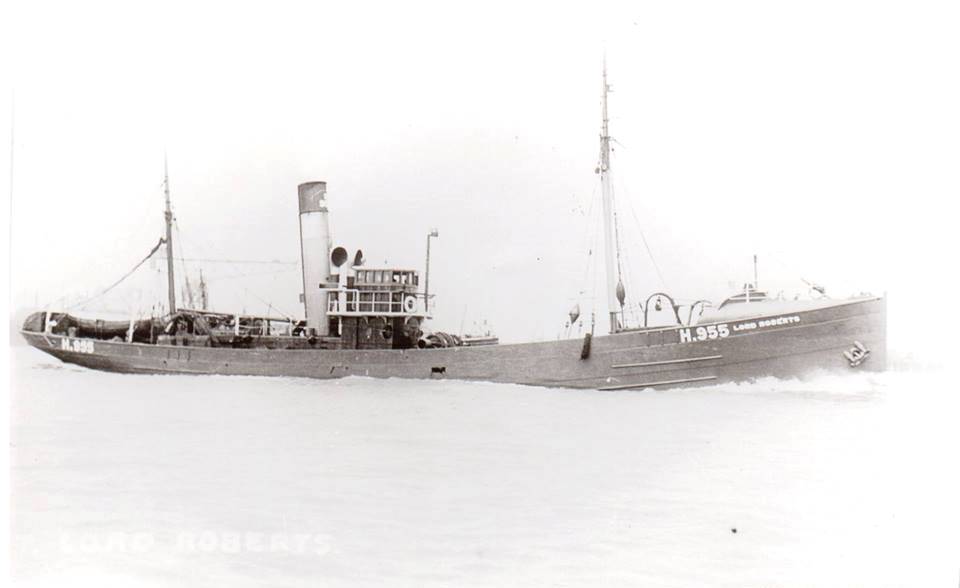
HMT Lord Roberts
HMT Lord Roberts was a Steam Trawler built by Earle’s shipbuilding in 1907, during her long career of patrol work in Harwich area she went to the assistance of many mined ships and rescued a very large percentage of their crews, unfortunately she was mined on the 26th October 1916 by a mine from the German submarine UC11, 9 persons were lost.
Ophir III
- Type. Steam Trawler
- Built. 1902
- Pennant. FY1204
- Builder. Cook Welton & Gemmell
- Laid Down. 1901
- Commissioned. 1915
- Speed. 10.5 knots
- Displacement. 230 tons
- Fate. Sank 1941
-
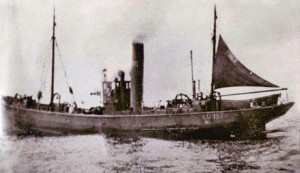
HMT Ophir III
HMT Ophir was launched by Cook, Welton & Gemmell, for Pickering & Haldane’s Steam Trawling Co Ltd.
1.1915: requisitioned for war service as an armed trawler
2.1915: renamed Ophir III.
124.10.1918: based Harwich.
By 12.3.1919: returned to owner at Grimsby.
Queen of the North
- Type. Paddle Minesweeper
- Built. 1895
- Builder. John Laird & Sons
- Laid Down. 1894
- Commissioned. 29/03/1916
- Displacement. 594 tons
- Fate. Mined 20/07/1917
-
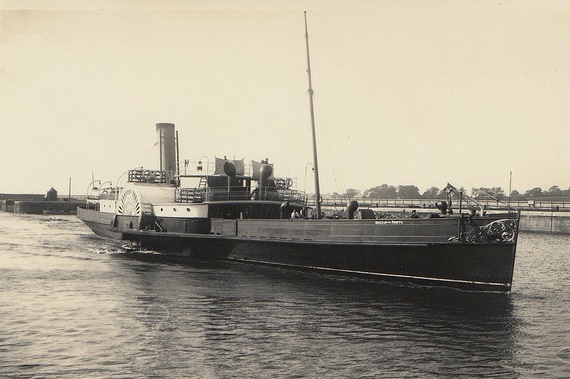
Queen of the North
HMS Queen of the North was a British built paddle-steam minesweeper built in 1895 by John Laird & Sons Birkenhead for the Blackpool Passenger Steamboat Company. She served the company until March 29th 1916 when the steel hulled ship was requisitioned by the Admiralty for use as a minesweeper.
On July 20th, 1917, Queen of the North was sunk by a mine from the German submarine UC-4 northeast of the Shipwash light vessel. 29 persons were lost.
Resono
- Type. Steam Trawler
- Built. 1910
- Pennant. GY508
- Builder. John Laird
- Speed. 10 knots
- Displacement. 230 tons
- Fate. Sank 26/12/1915
HMT Resono was an Admiralty trawler built by Cook, Welton & Gemmell, Beverley in 1910. On December 26th 1915 Resono was sunk by a mine near LV Light vessel off Harwich. 13 people were lost.
Sea Sweeper
- Type. Steam Trawler
- Built. 1915
- Pennant. FD171
- Builder. Cook Welton & Gemmell
- Laid Down. 1914
- Commissioned. 1916
- Tonnage. 329 tons
- Speed. 11 knots
- Fate. Sank 20/11/1939
-
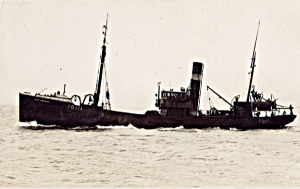
HMT Sea Sweeper
HMT Sea Sweeper was launched on the 31st May 1915 by Cook, Welton & Gemmell Ltd, Beverley for Humber Steam Trawling Co.
1.1916: requisitioned for war service as a minesweeper based Harwich.
20.11.1939: trawling 25 miles of Tory Island, Co. Donegal at 5.05 pm. stopped by U-boat (U33) crew abandoned to boat and subsequently sunk by gunfire; crew picked up by steam trawler Lois.
28.11.1939: sunk by enemy action.
Urie
- Type. Steam Trawler
- Built. 1917
- Pennant. FD163
- Builder. A. Hall
- Laid Down. 1916
- Tonnage. 226 tons
- Speed. 11 knots
- Fate. Scrapped 1960
-
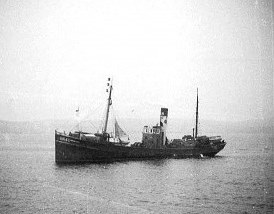
HMT Urie
HMT Urie was launched by A. Hall & Co Ltd, Aberdeen for Richard W. Lewis, Aberdeen.
5.1917: Requisitioned for war service and fitted out for armed escort duties. Based Harwich.
4.1960: Sold to Bisco and allocated to G. & W. Brunton, Grangemouth for breaking up.
Venator
- Type. MS Trawler
- Built. 1913
- Pennant. GY827
- Builder. Cochrane & Sons
- Speed. 11 knots
- Commissioned. 1915
- Fate. Scrapped 22/07/1937
HMT Venator was launched by Cochrane & Sons Ltd, Selby on the 22nd January 1913 for The Atlas Steam Fishing Co Ltd, Grimsby.
5.1915: Requisitioned for war service
12.3.1919: Returned to owner at Grimsby.
8.1928 Sold to Walter Garratt, Grimsby
8.1932: Sold to Martinus A. Olesen, Grimsby.
20.9.1932: Registered at Grimsby as Offa (GY827)
22.7.1937 Sold for breaking up.
Victorian
- Type. steam Trawler
- Built. 1900
- Pennant. GY1189
- Builder. Cook Welton & Gemmell
- Commissioned. 1915
- Displacement. 195 tons
- Fate. Sank 08/03/1940
HMT Victorian was launched by Cook, Welton & Gemmell, Hull for Willie A. Butt & William Hill, Grimsby.
8.1915: Requisitioned for war service as a minesweeper.
12.1915: Based Harwich.
8.3.1940: sunk by enemy action.
William Morrison
- Type. Steam Trawler
- Built. 1915
- Pennant. A355
- Builder. Aberdeen Pioneer
- Speed. 11 knots
- Displacement. 212 tons
- Fate. Sank 28/11/1915
HMT William Morrison was an Admiralty Steam trawler, built in 1915 by Aberdeen Pioneer Steam Fishing Co, Aberdeen, and Mined by the German Submarine UC7 on the 28th November 1915 near Sunk Head Buoy, off Harwich. 3 Ratings lost.
Worsley
- Type. Steam Trawler
- Built. 1913
- Pennant. GY814
- Builder. Cook Welton & Gemmell
- Speed. 11 knots
- Commissioned. 1914
- Displacement. 309 tons
- Fate. Sank 14/08/1915
HMT Worsley was a admiralty trawler, launched 1913 for E C Grant, Grimsby, hired 1914 as minesweeper, on patrol with a second trawler along the Suffolk coast between Sizewell and Shipwash LV, mined under the bridge at 1800, laid by UC.6 the previous day, broke in two and sank in under two minutes, one mile N of Aldeburgh Napes buoy, Suffolk.
Xylopia
- Type. Steam Trawler
- Built. 1911
- Pennant. M102
- Builder. Cochrane & Sons
- Commissioned. 1914
- Tonnage. 262 tons
- Speed. 11 knots
- Fate. Scrapped 1952
-
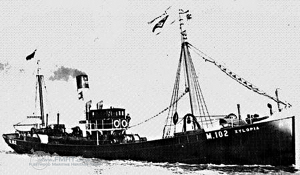
HMT Xylopia
© John Clarkson
HMT Xylopia was launched by Cochrane & Sons, Selby for Southern Steam Trawling Co Ltd, Waterford, 7.1914: Sold to the Admiralty and fitted out as a minesweeper.
28.12.1915: landed 9 survivors at Harwich from William Morrison mined and lost 2 miles of Sunk Head Buoy.
1952: sold to Bisco and allocated to C. W. Dorkin & Co Ltd, Gateshead for breaking up.
We are adding more information to this site on a regular basis, if you wish to submit any photos or provide any information on naval vessels that were based or visited Harwich, then please use the contact page at the bottom of the screen.
Copyright Ownership.
We attempted to get the consent of copyright holders to use this material for nearly all of the photographs on the website.
In the few cases where names are available, a thorough search was made using telephone directories, photographic copyright directories, People Search and Google Area Search. None of the copyright owners could be traced in this way and we believe we have exhausted all reasonable avenues.
The consensus opinion of these authorities was that if any two of the following situations applied we would be deemed to have taken sufficient action to avoid infringing copyright laws:
- Reasonable efforts made to contact the copyright holder
- No financial gain will be made in relation to the photos
- A letter is obtained from present owner of photos
- There is a proviso included stating that if offence is caused document will be removed
The website owner undertakes to remove any photograph from the website where offence is caused. All the above conditions have therefore been met.
Over 70,000 servicemen and more than 1,500 ships had been lost during the two World Wars, with these figures showing that while it may be ‘a sweet and honourable thing to die for your country’, it can also be a costly proposition.
The Commonwealth War Graves Commission ensures that 1.7 million people who died in the two world wars will never be forgotten.
← Minesweepers – World War 2 Destroyers – World War 2 →
